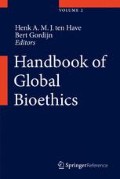Abstract
Article 8 of the UNESCO Declaration on Bioethics and Human Rights requires respect for human vulnerability and personal integrity – particularly for those who are especially vulnerable. While neither term is defined in the Article, arguably most people have an intuitive understanding of what is meant by them, and indeed in one form or another they appear time and again in international declarations, professional guidelines, and the wealth of literature surrounding the individual or group relationship with healthcare and its associated technical and technological advances. By examining the meaning of the Article in three settings – the routine clinical intervention, the research setting, and medical advances – its core elements of preventing exploitation of those who are disadvantaged because of health, social status, sex, age, and so on are clarified and discussed. In this way, and by use of concrete examples, it is possible to flesh out both the content of the Article and the obligations that it imposes of respect, nondiscrimination, and solidarity.
Access this chapter
Tax calculation will be finalised at checkout
Purchases are for personal use only
References
CIOMS. (2002). International ethical guidelines for biomedical research involving human subjects prepared by the Council for International Organizations of Medical Sciences (CIOMS) in collaboration with the World Health Organization (WHO), Geneva.
Coleman, C. H. (2009). Vulnerability as a regulatory category in human subject research. Journal of Law, Medicine & Ethics, 37(1), 12–18.
Corea, G. (1988). The mother machine: Reproductive technologies from artificial insemination to artificial wombs. London: The Women’s Press.
Declaration of Helsinki. (2008, October). 59th WMA General Assembly, Seoul. Available at http://www.wma.net/en/30publications/10policies/b3. Accessed on February 14, 2012.
Fox, K. (2002). Hotep’s story: Exploring the wounds of health vulnerability in the US. Theoretical Medicine, 23, 471–497.
Grady, C. (2009). Vulnerability in research: Individuals with limited financial and/or social resources. Journal of Law, Medicine & Ethics, 37(1), 19–27.
Hurst, S. (2008). Vulnerability in research and health care: Describing the elephant in the room? Bioethics, 22(4), 191–202.
IBC. (2011, June 22). Report of IBC on the principle of respect for human vulnerability and personal integrity SHS/EST/CIB-17/10/CONF.501/2 Rev 2, Paris. Available at http://unesdoc.unesco.org/images/0018/001895/189591e.pdf. Accessed February 14, 2102.
Iltis, A. S. (2009). Introduction: Vulnerability in biomedical research. Journal of Law, Medicine & Ethics, 37(1), 6–11.
Merry, S. E. (2007). Introduction: Conditions of vulnerability. In M. Goodale & S. E. Merry (Eds.), The practice of human rights (pp. 195–203). Cambridge: Cambridge University Press.
National Bioethics Advisory Committee (NBAC). (2001). Assessing risks and potential benefits and evaluating vulnerability. In Ethical and policy issues in research involving human participants, Vol. 1: Reports and recommendations of the National Bioethics Advisory Committee. Bethesda, MD: Author.
Rowland, R. (1992). Living laboratories: Women and reproductive technology. London: Cedar.
Ruof, M. C. (2004). Vulnerability, vulnerable populations, and policy. Kennedy Institute of Ethics Journal, 14(4), 411–425.
Schroeder, D., & Gefenas, E. (2009). Vulnerability: Too vague and too broad? Cambridge Quarterly of Healthcare Ethics, 18, 113–121.
Sherwin, S. (1992). No longer patient: Feminist ethics and health care. Philadelphia: Temple University Press.
Sulmasy, D. P. (2008). Dignity, rights, health care, and human flourishing. In D. N. Weisstub & G. D. Pintos (Eds.), Autonomy and human rights in health care (pp. 25–36). Dordrecht: Springer.
United Nations. Universal declaration of human rights. Available at http://www.un.org/en/documents/udhr. Accessed on February 14, 2012.
Author information
Authors and Affiliations
Corresponding author
Editor information
Editors and Affiliations
Rights and permissions
Copyright information
© 2014 Springer Science+Business Media Dordrecht
About this entry
Cite this entry
McLean, S.A.M. (2014). Respect for Human Vulnerability and Personal Integrity. In: ten Have, H., Gordijn, B. (eds) Handbook of Global Bioethics. Springer, Dordrecht. https://doi.org/10.1007/978-94-007-2512-6_71
Download citation
DOI: https://doi.org/10.1007/978-94-007-2512-6_71
Published:
Publisher Name: Springer, Dordrecht
Print ISBN: 978-94-007-2511-9
Online ISBN: 978-94-007-2512-6
eBook Packages: Humanities, Social Sciences and Law

